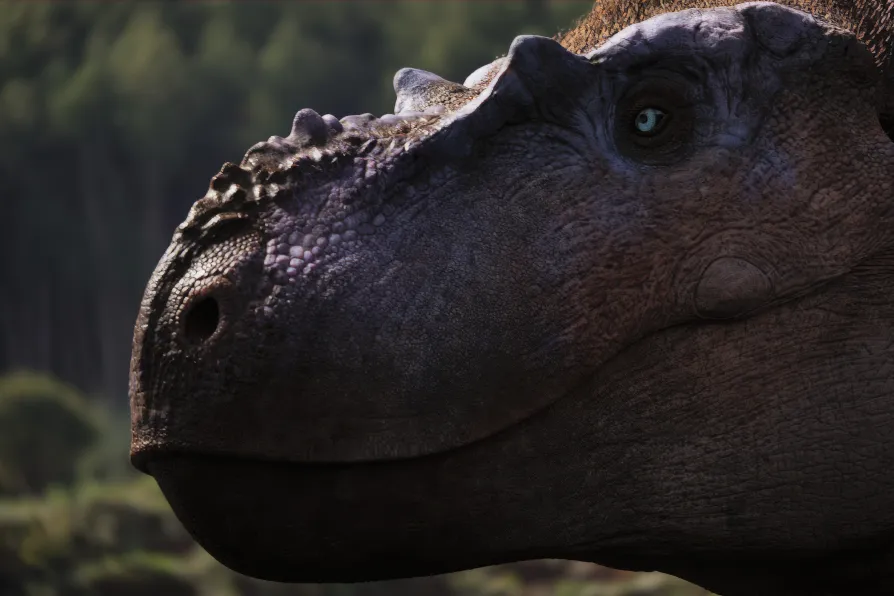After years hidden away, Oldham’s memorial to six local volunteers who died fighting fascism in the Spanish civil war has been restored to public view, marking both a victory for campaigners and a renewed tribute to the town’s proud International Brigade heritage, says ROB HARGREAVES
200 years since the first dinosaur was described and 25 after its record-breaking predecessor, the BBC has brought back Walking with Dinosaurs. BEN CHACKO assesses what works and what doesn’t

 T wrecked? A zoomed-in focus on individual dinosaurs, such as this young Albertosaurus, means the series fails to match the panoramic sweep of recent dinosaur documentaries Pic: BBC Studios
T wrecked? A zoomed-in focus on individual dinosaurs, such as this young Albertosaurus, means the series fails to match the panoramic sweep of recent dinosaur documentaries Pic: BBC Studios
THE BBC’S original Walking With Dinosaurs (WWD), broadcast in 1999, remains the most watched science programme in British television history. A title it may keep: the decline of terrestrial TV and a shift in viewer habits towards watching programmes online at times of their choosing means we may never again get 15 million viewers tuning into a show simultaneously, as its first episode did then.
Its long-awaited successor, aired 200 years since the first scientific description of a dinosaur in 1825 helped revolutionise geology and zoology, has had mixed reviews. Critics say it fails to immerse viewers in the illusion of watching a live nature documentary in the way the original did: a more disjointed narrative, with Mesozoic scenes featuring CGI dinosaurs interspersed with scenes from digs in which palaeontologists unearth bones, slows up the action. Cue negative comparisons with the recent David Attenborough-narrated AppleTV series Prehistoric Planet.
But that’s the problem: unlike 1999, there is now considerable competition in the CGI dino-documentary field. Were the BBC to repeat the format of 26 years ago, it would risk creating a series similar to existing ones and, given Apple’s enormous budgets, probably worse.
Similarly, the original series’ approach of telling “the dinosaur story” from beginning to end — proceeding chronologically from the first emergence of dinosaurs in the Triassic 230 million years ago in episode 1 to their terminal encounter with a meteor 165 million years later in episode 6 — worked for a mass TV audience, where millions not especially interested in dinosaurs might be expected to watch whatever was on on Sunday night.
Today’s audiences are self-selecting, a behavioural shift with all kinds of consequences in terms of societal atomisation and entrenched culture wars we need not consider here: for this review’s purposes it means the audience are probably already into dinosaurs, and don’t need to hear the classic story.
This widens the potential of popular palaeontology considerably, something taken advantage of both by Prehistoric Planet (which sticks to one point in time, 66mya, but travels the world revealing the enormous variety of dinosaurs in it) and the earlier BBC series Planet Dinosaur (2010), which jumped through time and across continents focusing on the unexpected — giant African fish-eating dinosaurs, tiny feathered gliders from China, co-operative nesting and hunting behaviours.
The last is probably closest to the new WWD format — Planet Dinosaur introduced moments “zoomed out” from the CGI action at which a narrator explained what fossil evidence lay behind the theorised behaviour shown.
However, the new series covers nothing like the variety of dinosaurs or geographic range. The giant African fish-eater Spinosaurus does make an appearance again — justifiably, since palaeontologists’ ideas of how it lived have changed significantly even since 2010.
But we don’t get the global picture of the other series — featuring animals from South America, east Asia, the Antarctic. Besides the one African episode, one is set in Europe and the other four are all North American.
The diversity of dinosaurs is also underplayed, with very similar ones recurring across the series — ceratopsians (horned dinosaurs of the Triceratops family) feature in three episodes, tyrannosaurs in three, and one duckbill genus (Edmontosaurus) in three — a consequence of the series’ “North America in the Late Cretaceous” bias.
This could have something to do with the format, which involves speaking to real palaeontologists on digs. Ever suspicious, I asked the BBC whether growing hostility to international co-operation in a new cold war meant this was no longer advisable with, say, Chinese palaeontologists.
This is possible — the original cold war obstructed scientific co-operation in all sorts of non-political fields, and I know of one documentary-maker warned off making a programme on Chinese poetry clubs for the BBC because of a new institutional aversion to all things Chinese. The show’s producers didn’t bite, however, only saying they had drawn on recent Chinese discoveries in designing some of the animated dinosaurs.
Their explanation was that the stories chosen reflected digs ongoing at the time of filming. This may explain why several episodes show quite similar creatures, but it does seem a shame not to have cast the net a bit wider.
This is also their explanation for the “pared-down” ecosystems shown — unlike Prehistoric Planet, we do not see landscapes teeming with ancient life.
Each episode follows an individual, based on an actual skeleton: a concept which gives the episodes a story-telling feel. What we gain is a detailed look at a dinosaur and insights into what, in its bones, suggests to us the story being told.
But a strict focus on species found within the digs concerned means the overall number shown is much lower, and the worlds depicted seem unrealistically barren — like watching a safari where no animals ever appear in the background or interact with the subjects. The forests, beaches and uplands stalked by the “lead” dinosaurs of each episode often seem like stage backdrops in consequence.
Some deride the “dig” scenes as boring: I didn’t think so, and explaining what features of a bone allow us to bring these remarkable creatures to life in our imagination is a good way to inspire the next generation of palaeontologists.
Scenes where scientists explain how the discovery of charcoal sediment in a fossil showed certain dinosaurs died in a forest fire, or how indications of blood vessels in a Triceratops frill showed it may have changed colour, echo the sense of wonder in recreating a vanished world evident in the writing of Gideon Mantell, the first man ever to describe a dinosaur 200 years ago, as he conjured from his collection of rock fragments “groves of palms and arborescent ferns” populated by creatures “of such prodigious magnitude that the existing animal creation present us with no fit objects of comparison… such a creature must have been the Iguanodon!”
There are flaws, however. As reviewer Marc Vincent observes, the palaeontologists are acting when explaining things to camera would be more effective: the staged conversations in which very knowledgeable people make very simple observations to each other about things they both obviously already know are unconvincing.
When fossils are found together, that means those dinosaurs died at the same time: something that requires an explanation, which is well done in the case of the flash flood that killed a herd of Pachyrhinosaurus, or the quicksand that trapped the Utahraptor pack. But a fossil found alone doesn’t imply the reverse, so storylines like that of episode 1’s Clover, a baby Triceratops portrayed as an orphan because her skeleton is unaccompanied, misrepresent what we can deduce from the bones.
These storylines are the most original feature of the series. After Clover we follow a “single dad” Spinosaurus (behaviour inspired by that of some modern birds, like the cassowary, where the male hatches and raises the young), a “teenage” Gastonia (an armoured dinosaur) and then a “teenage” Albertosaurus (a tyrannosaur), a baby Pachyrhinosaurus (a smaller relative of Triceratops), and a lovesick Lusotitan (a Jurassic giant similar to Brachiosaurus).
This risks anthropomorphism and an at times irritating cuteness that makes you wonder who the target audience is: the viewers who enjoy a baby CGI Triceratops befriending a baby CGI Edmontosaurus are surely younger than those who enjoy hearing the scientists explain the bones. As one dinosaur expert reviewer concluded exasperatedly, “at least the baby Edmontosaurus is devoured by a T rex in short order.”
The dinosaur animation is very good, if not always quite as convincing as in Prehistoric Planet. The depictions are based on the best evidence: the producers told me the very colours of the Utahraptor’s feathers (black, white and red) are based on recovered pigmentation on related Chinese fossils.
There are what I assume to be in-joke references back to related series: Spinosaurus loses its confrontation over a carcass with rival predator Carcharodontosaurus, when it wins against the same in Planet Dinosaur; Tyrannosaurus snatches and eats the giant pterosaur (flying reptile) Infernodrakon, when the latter’s relatives Quetzalcoatlus drive T rex off a kill in Prehistoric Planet. These will make dino-documentary fans smile.
It’s an original series, doing something new and educational with the format: and worth watching. But the concept narrows the focus too far, resulting in a show which doesn’t match its predecessors in depicting the Mesozoic world in all its weird magnificence.

RITA DI SANTO surveys the smorgasbord of films on offer at this year’s festival













